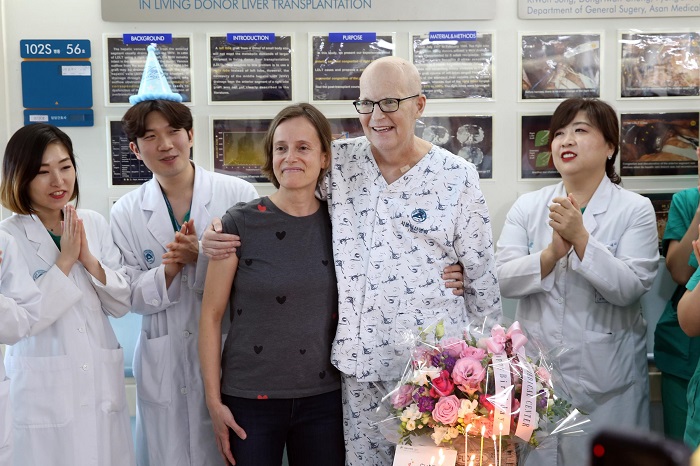
Charles Carson came to South Korea in November of last year, and received part of his wife’s liver on December 19. (image: Asan Medical Center)
SEOUL, Feb. 26 (Korea Bizwire) — An American citizen suffering from cirrhosis of the liver received a liver transplant and regained health at a South Korean hospital.
The patient was known to have come to South Korea as recommended by doctors at a major university hospital in the United States.
Charles Carson, a software engineer from Silicon Valley, was diagnosed with cirrhosis of the liver and myelodysplastic syndrome in 2011.
Myelodysplastic syndrome is a dangerous disease where a reduction in the number of red blood cells, platelets, and white blood cells can lead to immunity disorders as well as leukemia.
Carson was sent to Stanford University Medical Center for more than 10 rounds of chemotherapy, but his deteriorating liver condition did not allow him to continue the treatment.
He was soon after listed on the United Network for Organ Sharing to wait for a liver transplant.
Carson’s health worsened as time passed by without any news on the liver transplant, and he was not able to receive any treatment for myelodysplastic syndrome.
The key to Carson’s recovery was a living-donor liver transplant. However, American hospitals were hesitant to conduct a living donor transplant, fearful that complications could significantly undermine Carson’s health.
Doctors at the Stanford Medical Center recommended that Carson receive treatment at Asan Medical Center in Seoul, assuring Carson that South Korea was far ahead of the United States when it came to living-donor liver transplants.
After doing his own research, Carson was convinced, and decided to go to South Korea for treatment. Doctors at Stanford contacted Prof. Song Gi-won, a liver transplant specialist at Asan Medical Center, to ask for help with Carson’s treatment.
Carson came to South Korea in November of last year, and received part of his wife’s liver on December 19.
“For Mr. Carson, adhesion of the liver was particularly severe due to peritonitis caused by liver cirrhosis. Also, portal vein thrombus and collateral vessels required concentration and advanced surgical skills,” said Song.
A living donor liver transplant is known to take roughly 10 hours. For Carson, the operation took 18 hours.
Following the surgery, Carson had to be placed in an intensive care unit due to his unstable condition.
By mid-February, however, he was sent to the general ward to be with his wife. The couple returned to the United States on Monday.
“Mr. Carson will now be going back to Stanford Medical Center to receive therapy for myelodysplastic syndrome, and receive a bone marrow transplant,” said Song.
“We were able to conduct a successful transplant due to the trust of the patient and his family.”
H. M. Kang (hmkang@koreabizwire.com)






